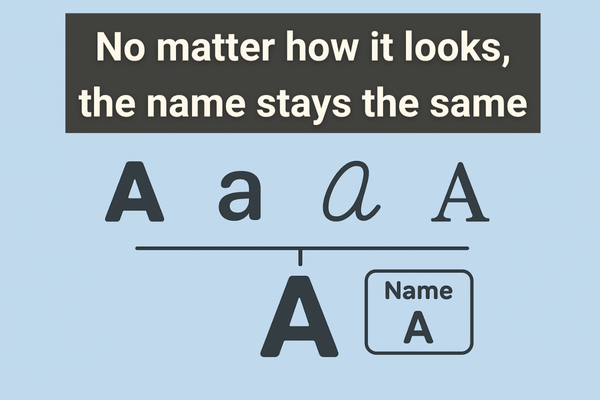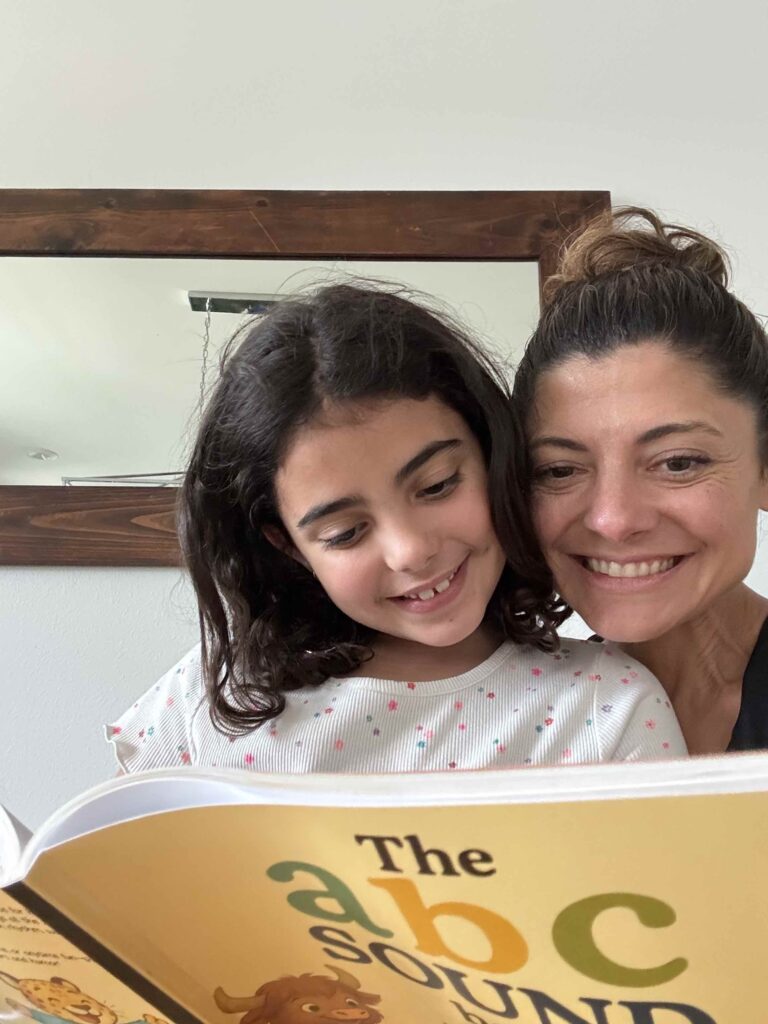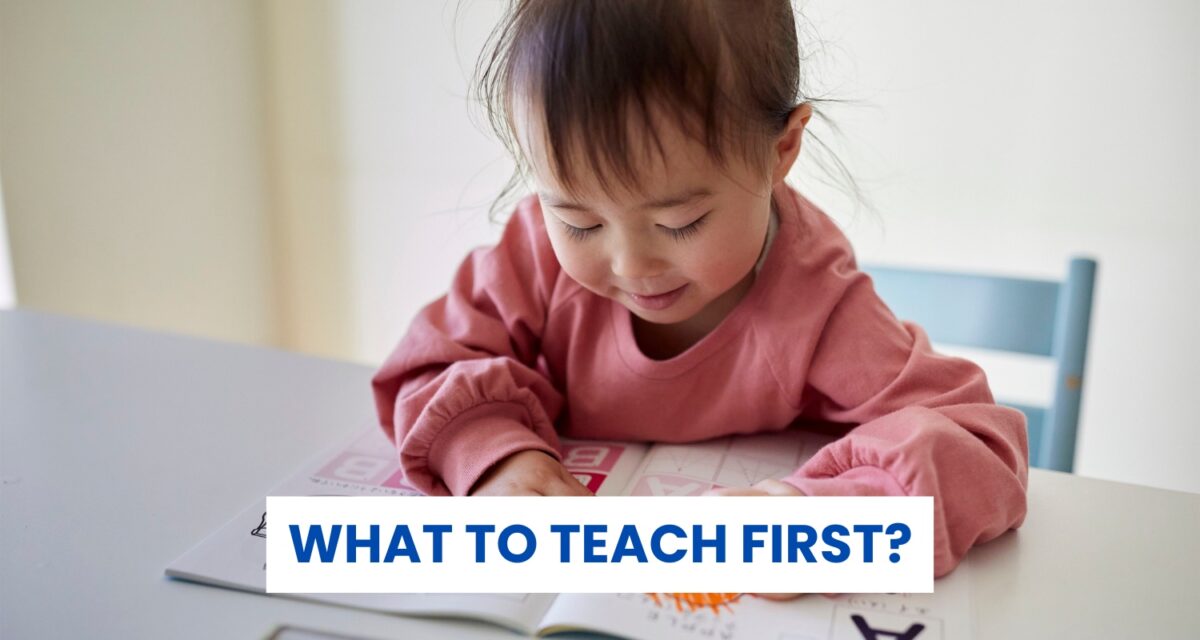If you’ve ever taught a child to read (or you’re in the middle of doing so) you’ve probably wondered:
Should I teach letter names or letter sounds first?
It’s a common question, and one that has sparked a lot of debate. Let’s look at what research has to say about this, what makes sense developmentally, and how to apply it in a practical way!
*Affiliate Disclosure: Some links lead to Amazon marketplace. As an Amazon associate, I earn from qualifying purchases, at no additional cost to you.
The Debate: Letter Names vs. Letter Sounds
In recent years, many parents and educators have been advised that at the very beginning of reading instruction, it’s best to skip teaching letter names and focus only on letter sounds.
Why? Well, the reasoning goes like this:
- Some letter names can confuse young learners. For example, the name of the letter Y (“why”) sounds nothing like the /y/ in yes. The same goes for H (“aitch”)—knowing the letter name is not helpful for sound association.
- When children start reading, they use sounds, not names.
- If we focus too much on names, children might start reading using letter names instead of sounds… which is not what we want!
It’s easy to see why this advice has gained traction. There’s truth to these statements.
However, it’s not as simple as it looks— there’s an interesting twist to the story.
It turns out that many letter names actually support letter sound learning… Let’s find out which ones!
When Letter Names Help to Learn the Letter Sounds
Some letter names can actually help learn the sounds, as the sound is embedded in the letter name itself.
Take the letter B, for instance. Its name, bee, starts with the /b/ sound.
The same is true for the following letters: D, J, K, P, T, V, and Z.
Some other letter names give us a partial clue, as their names end in the target sound.
Those partially helpful letters are F, L, M, N, R, and S
So, while some letter names are confusing, others are quite useful to learn the sounds…
This mix can add up to the confusion. What’s best, then? Letter names or letter sounds first?
What Does Research Say about the Letter Names Vs. Letter Sounds Debate?
Several studies have explored this exact question:
- A 2010 study by Piasta, Purpura, and Wagner found that children who learned both letter names and sounds together made stronger gains in sound knowledge than those who learned just one or the other.
- Another study from the same year found that knowing letter names actually helped children learn sounds, but the reverse wasn’t true.
- A 1984 study by Share and colleagues already showed that knowing letter names predicted reading success even more strongly than socioeconomic background, or how often parents read to their children.
Here’s something else fascinating— the easiest letter sounds for children to learn are often those that are “built into” the letter’s name itself.
Research by Treiman et al. (1998) found that children pick up these sounds faster because the name gives them a built-in clue, like a little phonetic hint that supports their memory.
Interesting right?
It turns out it isn’t about letter names vs letter sounds. Ideally, we should teach both at the same time.
💡 Teaching Tip: Make Letters Stick with Embedded Mnemonics
Did you know that children learn letter sounds faster and with fewer repetitions when the letter shape is embedded in a picture that begins with that same sound?
Research by Ehri and colleagues found that these “embedded picture mnemonics” help children link letters and sounds more easily, remember them longer, and confuse them less often.
Below is an example from our Embedded Mnemonics Alphabet Cards—a fun, evidence-based way to make learning letters meaningful and memorable.
Learn more here!
How We Got Here: From “Alphabet First” to “Sounds Only”
For many years, learning the alphabet meant one thing: reciting letter names, often to the tune of “Twinkle, Twinkle, Little Star.“
That used to be the norm and the focus in early education. The very first step was teaching kids to recite the alphabet.
Children could sing their ABCs perfectly but often had no idea what those letters represented. They might know that “this one is called B,” but not that it makes the /b/ sound, as in bat.
So, it’s easy to see how the “Alphabet First” approach fell out of favor.
Reciting letter names by rote, without any understanding of their sounds or purpose, doesn’t move children closer to reading. It’s a bit like memorizing the names of chess pieces without ever learning how they move!
Why Teaching Both Works so Well
We don’t know why exactly teaching both works so well, but these are a few hypotheses.
It could be because letter names are the most stable property of a letter. What that this mean? Well, think about it! The shape of a letter changes (uppercase, lowercase, or in different fonts). The sound can change too; for example, a in apple vs. cake. But the name of the letter never changes.
That stability could give children an anchor point, something solid to hold onto as they begin connecting print with sound.

Some experts suggest teaching both at the same time is better because many letter names contain helpful sound cues (T, P, B). This argument is coherent with the fact that those letter sounds tend to be learned more easily, as we’ve seen before (Treiman et al. 1998 research).
Others think that letter names give children a mental “handle” for remembering what letters represent.
By naming letters, we’re making them real and concrete. Otherwise… what are letters, really? They are abstract entities. Giving them a name helps children make sense of this tricky idea.
The truth of the matter is that it’s all pure speculation. Anyway, whatever the reason/s, evidence consistently shows that letter name knowledge supports letter sound learning, especially when taught side by side in a clear and structured way.
💡 Teaching Idea: Use Stories to Teach the Sounds!
A fun and natural way to learn the sounds is through stories!
That’s what makes The ABC Sound Book: Playful Phonics Stories for Every Letter such a handy (and powerful) tool for parents and early educators.
This alphabet book helps children connect each letter to its main sound through playful, rhyming stories.
Learn more here!
- Diaz, Laura (Author)
- English (Publication Language)
- 110 Pages – 07/13/2025 (Publication Date) – Learning Reading Hub (Publisher)
Recommended Approach (backed up by research)
Based on what research has found to work best, these are my recommendations:
- Teach letter names and sounds together from the start. When you introduce them, say:
This is the letter ‘a.’ The letter ‘a’ makes the /a/ sound.”
“This is the letter ‘b.’ The letter ‘b’ makes the /b/ sound.”
- Prioritize the sound when reading.
I like to explain it in this way: Letters have names, just like you and I do. But they don’t go around shouting their name all day, just like I don’t walk around yelling “Laura, Laura, Laura!” Instead, they have a favorite sound, and that’s what they say… most of the time!
Extra Tips for Success When Teaching the Letters
- Use multisensory strategies (sandpaper letters, finger tracing, or writing while saying the name and the sound) Also, as mentioned before, one of my favorite tools for teaching the letter sounds are embedded mnemonics. Learn more here!
- Be clear and consistent, especially with letters where the name and sound don’t match.
- Use repetition, songs, books—and be patient. Learning the letters is hard most kids… and it takes time!

Quick Tip: Songs for Letters
Before using a song, ask: Are you teaching letter names, letter sounds, or a specific sound?
As a general rule, I like songs (like our Sing the Letters, Say Their Sounds) that clearly introduce both letter names and sounds, while putting more emphasis on the sounds.
Some ABC songs often move too way fast (think of the “ELEMEN OP!” part in the Alphabet Song to the tune of “Twinkle Twinkle Little Star” ), not giving enough time to kids to process that these are actual letters!
On top of that, some letter-sound songs say the sounds incorrectly, adding an extra /uh/ at the end of consonants (for example, saying “buh” instead of a clean /b/), which can confuse children and slow reading progress.
Choose songs with a clear purpose, maximizing the potential of this powerful tool!
Final Thoughts
Should we teach letter names or letter sounds first?
The best answer is… teach both (at the same time) with an emphasis on sounds when reading.
Some people may choose to start with sounds only, and that’s a valid approach.
However, remember that research shows that, when done right, teaching names and sounds together doesn’t hinder learning—it actually boosts it.

Hey there! I’m Laura – an author, YouTuber, blogger, and the creator of the “Learning Reading Hub” platform. I created this space to dive into the world of reading instruction and to shout from the rooftops about how vital it is to use the right methods for teaching reading. I’ve got a TEYL certification (Teaching English to Young Learners), plus a Journalism degree from the University of Navarra in Spain, along with a Master’s Degree in Communication.
I’ve always loved digging into research, jotting down my thoughts, connecting with people, and sharing what makes me tick. With a background in marketing, digital projects, and the education scene (especially language learning), I’m all about wearing different hats.
When my first kid needed to learn how to read, it opened my eyes to the challenges and complexities involved. This journey took me through a rollercoaster of self-teaching, eye-opening discoveries, and yeah, some letdowns too. There’s so much conflicting info out there, along with methods that just don’t cut it. And let’s face it, these issues are way too common.
Now, I’m all about channeling that passion (without sounding like a know-it-all!) and sharing my journey. My mission? Making it easier for those who are on the same path I once was.
My heart’s with my family and the amazing Learning Reading Hub project. I live with my husband and two little ones, raising them in a bi-lingual environment (English and Spanish).



